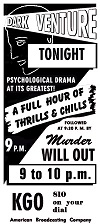
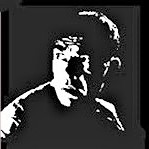
Shadows of greed and hate, jealousy and fear.
Darkness is the absence of Light . . .
So in the sudden shadows which fog the minds of men and women
. . . into the unknown.”
Dark Venture (1945-47) aired “Turnabout” on August 20, 1946. This is the first show we have run of what was billed as a “psychological thriller.” Aside from the fact that there were 130 episodes of which a mere dozen survive, there is so much mis-information, innacurate information, and conflicting information among many online old time radio websites (some reportedly reputable and authoritative), that I turned to long-time friend of this show and Golden Age of Radio historian Karl Schadow for help. Karl wrote the liner notes for the Radio Spirits CD collection of Dark Venture, and with his kind permission–and my thanks–I will excerpt from his far more in-depth introduction, wherein he details the history of this under-appreciated radio show.
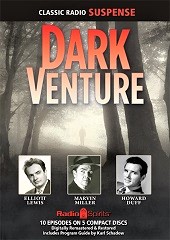 “Dark Venture premiered on June 5, 1945, enjoying a continuous run through December of 1947. During this thirty-one month period, all of the episodes were produced and broadcast from various facilities of station KECA, ABC’s Hollywood affliate. The cast was an interesting mix of performers. Not only were elite actresses Jeanne Bates, Betty Moran and Lurene Tuttle featured in the series, but opportunities were also bestowed upon radio newcomers Daphne Drake and Martha Shaw. The men’s roles were often given to stalwarts Charles Lung, Earl Ross and Bill Johnstone. Stage and screen stars occasionally appeared on the program as well, resulting in impressive individual performances by William Tracy and Carl Harbord.
“Dark Venture premiered on June 5, 1945, enjoying a continuous run through December of 1947. During this thirty-one month period, all of the episodes were produced and broadcast from various facilities of station KECA, ABC’s Hollywood affliate. The cast was an interesting mix of performers. Not only were elite actresses Jeanne Bates, Betty Moran and Lurene Tuttle featured in the series, but opportunities were also bestowed upon radio newcomers Daphne Drake and Martha Shaw. The men’s roles were often given to stalwarts Charles Lung, Earl Ross and Bill Johnstone. Stage and screen stars occasionally appeared on the program as well, resulting in impressive individual performances by William Tracy and Carl Harbord.
“For the frst ten months, Dark Venture was a regional feature, limited to broadcast on ABC’s Pacifc Coast network, which consisted of fifteen stations in fve states. After commencing on Wednesday’s at 9 pm, the program moved to Tuesdays in July of 1946. It is currently unknown why ABC did not initially route the program to the entire nation. However, on February 19, 1946, it did achieve full network coverage. Two months into this series, the New York Times (April 7,1946) published Larry Marcus’ compliment to the wisdom of his audience, who demanded scripts that would have to involve “believable characters and natural situations out of which will spring movement and suspense…to tell an honest story of emotional upheaval.”
…
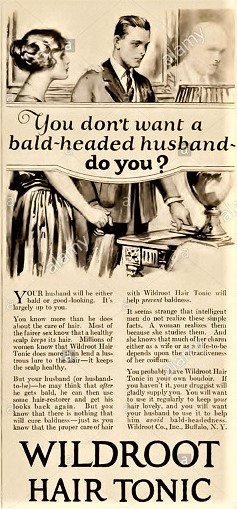 “On April 16th, 1946, Dark Venture entered the commercial ranks. The Wildroot Company, through its long-time advertising agency Batten, Barton, Durstine &Osborn, signed on as sponsor to promote its Cream-Oil Hair Tonic through April 8, 1947.”
“On April 16th, 1946, Dark Venture entered the commercial ranks. The Wildroot Company, through its long-time advertising agency Batten, Barton, Durstine &Osborn, signed on as sponsor to promote its Cream-Oil Hair Tonic through April 8, 1947.”
…
“Previously aired episodes of Dark Venture (from 1946) were adapted for use by the Armed Forces Radio Service (AFRS) and broadcast without Wildroot’s promotional copy. The program was one of many to be featured on the AFRS Mystery Playhouse. Hunter Galloway was this series’ narrator.”
And finally, “During the initial West Coast run of Dark Venture, the Hollywood-based Radio Life (January 27, 1946) acknowledged that the series “offers realistic psychological studies of men and women with troubled minds who choose the hard way, the fast way, the wrong way to solve their problems.” Once the program garnered a coast-to-coast audience, many newspaper editors expressed opinions similar to those of Mike Mann of Knickerbocker News, Albany, New York. He called the show “one of radio’s standout dramas…a psychological thriller with plenty of action.” Walter Winchell championed Dark Venture in his daily syndicated column (April 14, 1946), declaring it to be “gifted with fne word weaving–a rarity among radio dramas.”
***
This episode is one of the AFRS rebroadcasts Karl mentions above, and is the version currently in circulation today. “Turnabout,” as is typical of a Dark Venture story but hardly the most hard-core example (other episodes make this one look tame by comparison), is the story of a self-centered man who will stoop to anything to get what he wants. He is a greedy man who has embezzled $50,000 from the company he runs with his partner. When confronted by the partner, he explains that he has spent the money on lavish gifts for his mistress. Promising his partner to pay it back, he then runs into trouble and decides to take a short cut–which leads to more serious trouble and what he believes is a perfect cover up. Alas, the devil is in the details, and the one he overlooks leads to his eventual downfall in a most unusual manner. Like many a Dark Venture episode, there is a delicious twist at the end punctuating the tale with a needle-sharp sting, and which the listener (much less the Bad Guy) rarely sees coming. I’ll be sharing more episodes of Dark Venture in the near future, ones with sociopathic characters so despicable you might wonder how their depraved stories got past the censors of the time. But that’s another story. For now, you’ll have to get your jollies from the comeuppance a pathetic little man receives as his just reward in “Turnabout.”
Play Time: 24:49
{After listening to such a grim story as “Turnabout” the neighborhood gang wanted nothing more than to raise their spirits by looking to some of their favorite magazines, so headed as one to the corner newsstand for exciting tales full of action and adventure, and it was a great selection they had to choose from in August of 1946, with both summer and school vacation soon coming to an end. Planet Stories (1939-55) was the playground for many a fanciful tale of planetary romance and the issue below would prove to be quite the collector’s item, for it featured the only collaboration between Leigh Brackett (first half) & Ray Bradbury (last half) of the classic story “Lorelei of the Red Mist.” Planet Stories was a quarterly in 1946. Startling Stories (1939-55) also thrilled young readers with colorful adventure tales and an innocent but glorious sense of wonder suffusing every page. The issue below featured a reprint from Edmond Hamilton (on December 31, 1946, Edmond Hamilton & Leigh Brackett would marry) and an original (now classic) short novel by none other than the great Henry Kuttner. Startling Stories was a quarterly in 1945, went to 5 issues here in 1946, and in 1947 upped its game to a bi-monthly. Thrilling Wonder Stories (1936-55) rounded out the Summer 1946 trio of pulps the gang snatched up with relish, all three beckoning with the allure of strange worlds and improbable science married to tried-and-true action plots. In 1946 TWS saw five issues, but from 1947 until the final couple of years before its demise, it was a bi-monthly. Unfortunately, 1955 turned out to be the final year for all three of these cherished magazines, putting yet another nail in the coffin of SF’s pulp era.}
[Left: Planet Stories, Summer 1946 – Center: Startling Stories, Summer 1946 – Right: Thrilling Wonder Stories, Summer 1946]
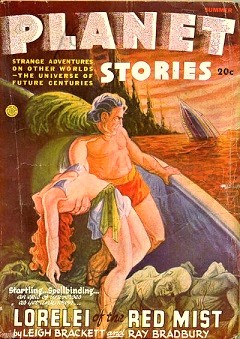

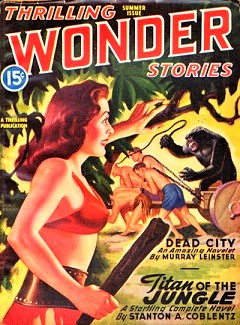
To view the entire list of weekly Old Time Radio episodes at Tangent Online, click here.